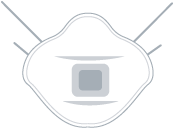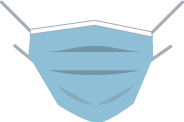PPE staff leaflet
Last updated: 28 October 2021 at 20:18
The transmission of COVID-19 occurs mainly through respiratory droplets generated by coughing and sneezing, plus through contact with contaminated surfaces.
The wearing of surgical face masks by all staff in non-clinical and clinical areas of our hospital settings will play a significant role in reducing further transmission of COVID-19. These measures are in place for the safety of you and our patients. In some areas a higher standard of PPE will be required.
All staff are reminded that where practicable, we should all adhere to social distancing principles (by ideally two metres). Staff should also always complete optimal hand hygiene and frequently decontaminate surfaces. The good ventilation of spaces is also important in reducing the risks of COVID-19.
Respiratory protection
- Staff must wear a face mask or face covering on entering the hospital
- On arrival to area of work – assess the situation and choose the type of respiratory protection required (e.g. type IIR surgical mask for a ward area, or FFP3 respirator if it is high risk area carrying out aerosol generating procedures)
- If required to wear an FFP3 mask only wear the type of mask that you have passed fit testing on
- If staff have not been fit tested they should wear a respirator hood
- The staff member should then arrange an appointment for fit checking by contacting their line manager/clinical educators/IPC
What PPE to wear
A visual guide for the recommended use of PPE in different clinical areas is available from the 'related pages' section.
The key principles for PPE usage are:
- You must decontaminate your hands between patients
- You must change gloves/aprons between patients
- Remember to avoid touching your mouth, nose and eyes
- COVID-19 is spread predominantly by respiratory droplets, hence surgical masks are appropriate for routine care
Sessional PPE usage
- A session refers to a period of time where a healthcare professional is caring for patients in a clinical setting
- Masks, visors and gowns can be worn for prolonged periods and unlike gloves and an apron, do not need to be changed between patients
- PPE should be disposed of if it is damaged, soiled or uncomfortable
- Avoid touching the mask on removal, place into a clinical waste bag and wash hands
Reducing skin damage risk
To reduce the risk of skin damage, prior to applying the mask please ensure skin is clean and dry, do not over tighten the mask, please ensure a comfortable fit is achieved before attending to a patient.
For advice or support with skin issues, please see the 'prevention and management of PPE skin damage' page.
PPE concerns
Should you have any queries these can be escalated to your line manager. Failing this, queries can be sent to the PPE group via email and indicating the clinical query in the subject box.
Email: COVID19PPE@uhb.nhs.uk
When to use an FFP3 respirator

Within two metres of patient and carrying out potentially aerosol generating procedures for patients suspected/confirmed of having an infectious respiratory illness, such as Flu, Pulmonary TB, Coronavirus.
Aerosol generating procedures include:
- bronchoscopy
- endotracheal intubation
- tracheostomy procedures
- cardiopulmonary resuscitation
- diagnostic sputum induction
When attending a patient in a bay or side room, within one hour post aerosol generating procedure.
PPE to be worn:
- FFP3 respirator mask
- Long sleeved disposable apron
- Gloves
- Eye protection
Patients should not wear FFP3 respirator masks as they are not fit tested.
When to use a surgical face mask

Providing patient care, direct home care visits, diagnostic imaging, phlebotomy services, physiotherapy (when not performing an aerosol generating procedure).
Please note during a pandemic, mask use is sessional and may be required in all clinical areas.
Close patient contact (within two metres of patient).
PPE to be worn blue side out:
- Blue surgical face mask
- Standard apron
- Gloves
- Eye protection (if risk of contamination of eyes by splash or droplets)
Patients should wear a surgical face mask for transfer to other wards and departments.
Do’s and Don’ts
How to wear a face mask safely.


